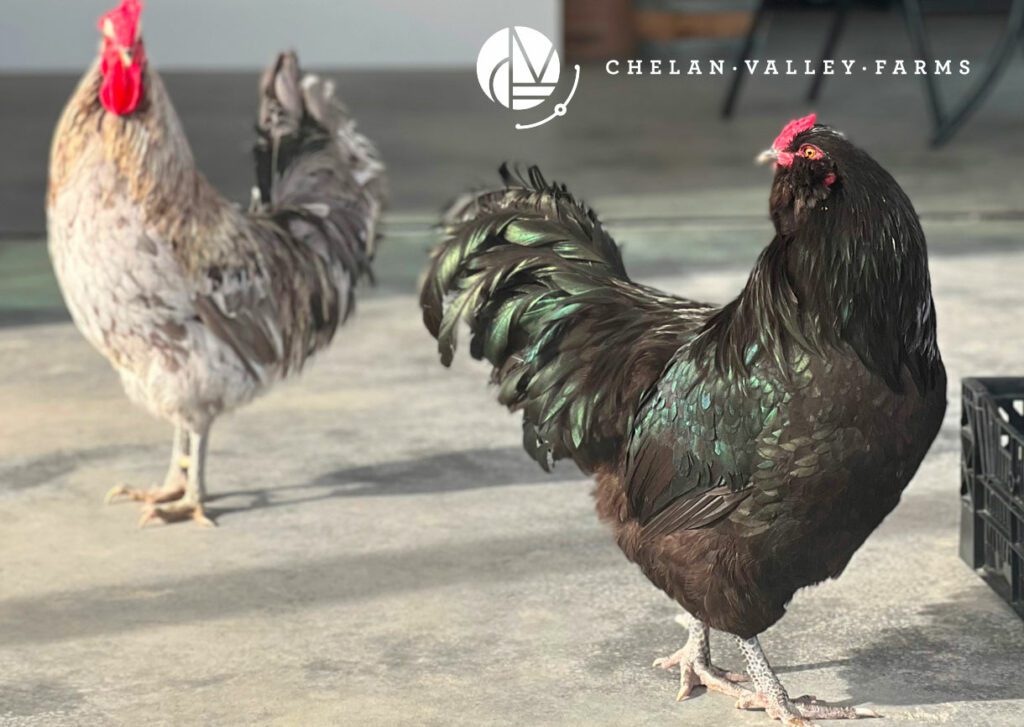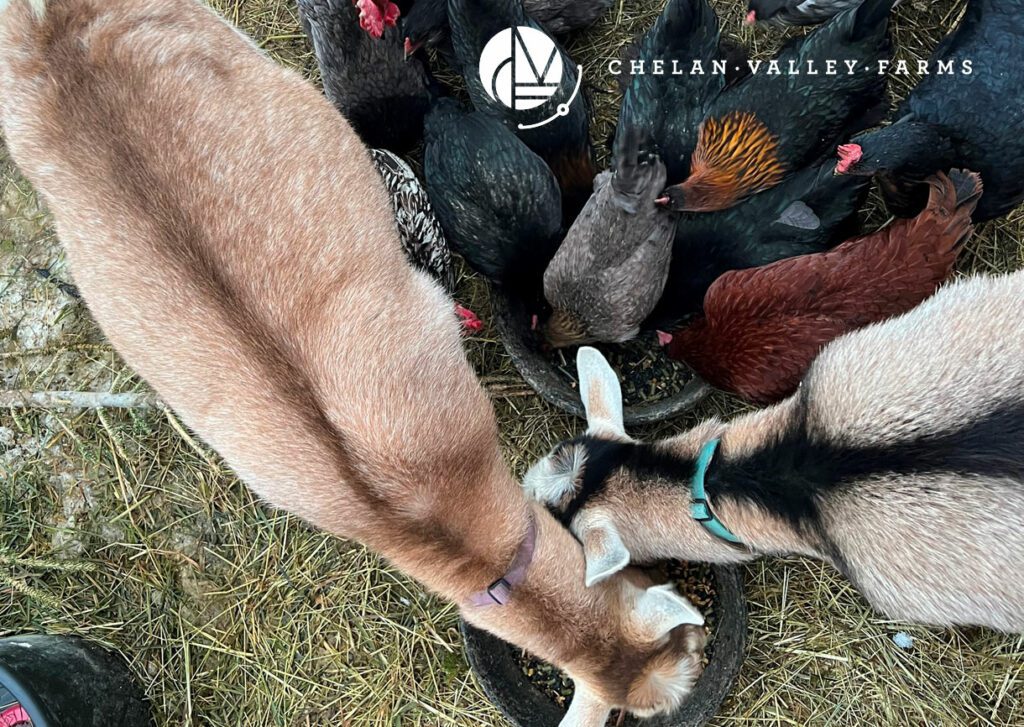Animals: why we’re incorporating them and how they improve the farm.
Are we a winery? Are we a vineyard? Are we a farm? Is it possible to be all the above? The answer is yes, yes and yes, then yes. How? Animals bring all the parts together. They can help with weed control, they bring diverse life and fertility to our soils. These are big parts of why we’re bringing animals to the farm. The next question is – what animals make sense on the farm? Each specie has distinct food preferences and eating patterns. And each crop we grow may or may not be a match for a specie at all or simply based on time of year. Then, I’d like to share some examples of vineyard/farm operations using animals in wine grapes and orchards.
I’ve spent my career learning modern conventional agriculture around the world. Modern agriculture is a gift to humanity. Today’s farmers provide abundant, inexpensive food for a massive population – its up to 8 billion people. What I hope to share in this article is little bit about how animals being brought back to the farm can be the next great evolution in creating more sustainable, healthy food. For us that’s wine grapes, apples, flowers and pumpkins.

Two of our prized rooster breeds, Sven (Swedish rooster, olive eggs) and Toker (@willowridgefarmwa Ameraucana rooster, blue eggs)
Why animals on the farm and which ones?
We’re bringing animals to the farm because we want to create healthier soil, benefit from their natural fertilizer and have them help control our weeds. I’II talk healthier soil first, and focus ‘primarily’ on organic matter. “A typical agriculture soil has 1-6% organic matter by weight.” (https://sare.org, Building Soils for Better Crops: Chapter 2). “A handful of soil contains more organisms than the total number of people that have ever lived on earth.” – Kris Nichols, Soil Microbiologist.
Organic matter consists of three distinctly different parts: 1. living organisms (earthworms, virus, fungi, plant roots, insects and much more), 2. fresh residues (deceased microorganisms, plan trouts, crop residue AND recently added manures) and 3. molecules derived from decomposed residues (items difficult for organisms to decompose such as humus or remains of microorganisms). Organic matter is absolutely vital to healthy soils even though its only a small percentage of the soil make up. Now I’ve covered a basic definition of organic matter – how do animals contribute to it? I won’t have to belabor this one – cows, pigs, sheep, goats, chickens, geese (and more, like rabbits) eat plants. Then they poop. Their poop or manure is organic matter. This manure is amazing food for microorganisms in the soil. Imagine the diversity of food and life manure brings to the soil. It also contributes to soil structure. But let’s not get too carried away because all manure isn’t made equal and there can be such a thing as too much of a good thing. Therefore, this is a great place to transition to the fertility benefit from animal manure.
Some things to consider about manure and its fertility benefits: l. Is it left behind from animal grazing? 2. What type of animal, and is it composted (or does it need to be)? and 3. What nutrients do your plants need?
Manure left behind from grazing
The obvious benefit being that you don’t have to apply it, the animals do. Key question – how long do the animals remain and how many are there? Enter rotational grazing. Check out Alan Savory’s work if you’re interested – I was fascinated watching this 10 years ago… and was amazed it was 10 years ago.
Watch Alan Savory Ted Talk: How to fight desertification and reverse climate change
This in and of itself could be its own topic. I have a lot more to learn on this one – but its important to introduce – what are the crops needs and what would the amount of “fertilizer” left behind from the grazing event be (more in a moment)?
What type of animal?
Cows, pigs, sheep, chickens, geese and goats produce manure that’s considered “hot” and needs to be composted. If their manure is collected and applied without composting it can be high in ammonia or pathogens such as E. coli. An animal like rabbits on the other hand creates manure that doesn’t require composting (considered “cold”) because its lower on the list as a carrier of pathogens and their manure doesn’t contain as much ammonia. The big epiphany here for me is – not all manure is made equal – so we need to pay attention to what animal its coming from and if it needs to be composted. This makes the need to get it tested or ask for the nutrient analysis incredibly important. Blindly applying manure would be a mistake.

We’ve started with goats (our brush clearers) and a diversity of chickens.
What nutrients do your plants need?
Do this! Test your soil (message us if you need guidance), find out what your plants need and figure out what your animal manure will deliver. There are now known to be 18 essential nutrients plants need – N-P-K and 15 micronutrients. Its amazing to think that for 100’s of years farmers have been using animals to help create healthy soil. Their manure is an amazing contributor to organic matter and soil fertility. But what about weeds?
I had no idea how different animals grazing patterns and natural diets are. This obviously directly relates to the diet we plan to expose them to on the farm – in the vineyard or orchard. The literature is very specific on each species plant preference AND even goes as far as what part of the plant. Example: if cattle first prefer to eat the tops of the grasses, then come back and eat the lower parts later. I’ve seen where our goats totally prefer to eat the seed heads off of common mallow (not a native weed) before eating any of the foxtail. As a result, our goat pasture has turned to mostly grasses and the mallow has started going away. Now let’s look at geese. We’re considering using geese (in combination with a neighbor’s sheep) to graze in our grapes and help control weeds. It turns out geese naturally prefer grasses. For the most part the weeds we have in our grapes are grasses – but I’ve also read you can feed the goslings a diet focused on the weeds you’d like them to eat. This sort of trains them to change their diet. The last example I’d like to share is chickens. Chickens are omnivores – meaning they eat plants and animals (think insects). We’d like to scale up the use of chickens on the farm over time. They can be used to help control cut worms in the vineyard and they love to eat alfalfa, clover, mustard and other plants. To wrap this up – it’s easy to see how animal choice on the farm needs to be thought through. The example species I shared and other species do great things to create healthy soils.

Bingo (black) and our favorite Livestock Guardian Dog (LGD) (black and white) the Karakachan.
Examples of Farms Incorporating Animals
Tablas Creek
I’ve mentioned this vineyard and winery before. They’re located on the Central Coast of California, grow grapes and make wine. Follow them on Instagram @tablascreek. They were also the first Regenerative Organic Certified vineyard in the U.S.. They’re using sheep, chickens and other animals in their operation. The Spanish Mastiff livestock guardians are really cool.
Paicenes Ranch
This operation is impressive. They focus on livestock, annual crops and vineyard. Its hard to summarize all of what they’re doing and how committed they are to sustainable farming. One relatively new and unique thing they did was designing and planting a vineyard with a trellis high enough to allow year-round grazing in the vines – pretty cool. What they’re trying to figure out with annual crops is pretty cool as well. How to build the soil in an annual cropping system – minimizing tillage, keeping the soil covered and more.
ACRES USA Magazine
This magazine has been eye opening to me. Spending my career around mostly what are considered “conventional” systems – this magazine has introduced me to lots of new things. Check out the December issue. You can buy it electronically for $6. The article in there about chickens was fascinating. Did you know chickens originated in jungle environments…? The take home for me on this was the amount of “cover” they prefer to forage comfortably is 60%. This is enough cover for them to roam but feel like they can safely hide from predators. I keep reconsidering if chickens are really stupid like is often said – when we’ve never had to “teach” a chicken to go into the roost at night, they just do it on their own.
Conclusion
Some of our plans for animals moving into the farm are visionary and will take time. We’re a small farm. Me helping out on the weekends isn’t enough when we start talking about rotational grazing. We do have 60 chickens and a couple goats. We’re applying for a grant to help us get fencing so we can start to graze the grapes. And, if you’ve visited you’ve seen our beautiful Livestock Guardian Dogs – Jade and Angel. Livestock Guardian Dogs are definitely an animal that’s a must to help protect our animals. As we head down the path to improve soil health – I hope what I’ve shared is insightful, if it’s something you’re also considering. Animals ability to help build organic matter, naturally fertilize and weed is an amazing blessing. But keep in mind – all animals manure isn’t made equal. Also – remember to test your soil. Test your soil to know what you have before you start adding to it. Wilbur-Ellis (the company I work for full time) has great resources to help you tackle soil needs. Then check out growers already successfully using animals. Not only are they inspiring but their modeling the way. So maybe the next time you visit the farm we’ll have more animals for you to visit as we continue our journey toward becoming Regenerative Organic.





I have been so impressed with Tablas Creek and what they’re doing! Looking forward to seeing what Paicenes Ranch is doing! Great info!!
We’re so fortunate they’re sharing about the great things they’re doing!!